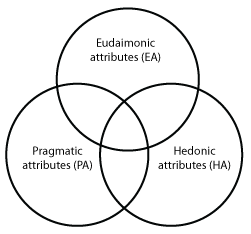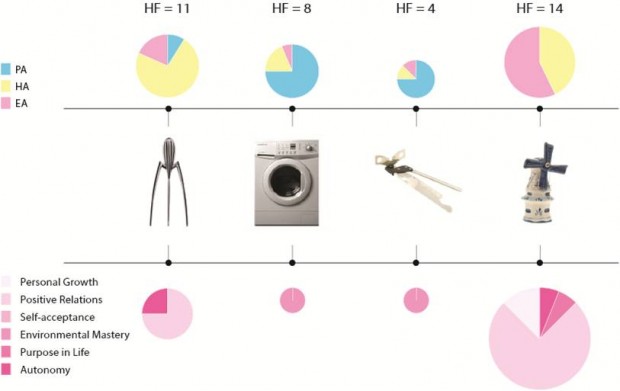Many companies claim to make you happy with their products for example Ola (ice creams) introduced “Happiness Stations”, Center parks tourism offers “A state of Happiness” and you will discover “The Story of Joy” when driving a BMW car. However, not all of these products offer the same kind of happiness; you can be happy anticipating and eating an ice cream, but this feeling fades away quickly and can even make you sad or angry with yourself if you wanted to eat healthier and lose weight. On the other hand, your running shoes might not always fill you with joy when you see them, but when you are running and enjoy the beauty of the forest or you are totally absorbed in the activity and forget your worries, this fills you with a satisfied and relaxing feeling which even lasts after you’ve returned because you did something healthy and good for yourself. How do you know what the impact is of a product on your well-being?  Figure 1 model of product-attribute categories
Figure 1 model of product-attribute categories
The aim of this research is to answer that question; to unravel and visualize the effect of products on your well-being. First product-attribute categories relevant for well-being are identified. This resulted into three categories; pragmatic, hedonic and eudaimonic attributes (see Figure 1). Based on these categories a questionnaire was developed to assess the different attributes of random products. The research of Hassenzahl et al. (2000) and Hassenzahl (2001) was used as a basis for the pragmatic and hedonic attribute items and Ryff’s questionnaire for the dimensions of psychological well-being (Ryff, 1989) was used for the eudaimonic items. After a content validation phase with experts, the constructs were validated with an on-line questionnaire completed by 100+ participants.
The development of a quick assessment tool of which the outcome a product happiness profile is, is in progress. This product profile will show the designer and clarify the user how the product will contribute to the user’s happiness (see for a hypothetical example Figure 2); it visualizes and specifies the product’s “happiness factor”.
Figure 2 Example of product happiness factors and profiles
References
- Hassenzahl, M., Platz, A., Burmester, M., Lehner, K. (2000). Hedonic and ergonomic quality aspects determine a software’s appeal. In Proceedings of the CHI 2000 (pp.201-208). New York: ACM Addison-Wesley.
- Hassenzahl, M. (2001). The Effect of Perceived Hedonic Quality on Product Appealingness. International Journal of Human-Computer Interaction, Vol. 13 (4), 481–499.
- Ryff, C.D. (1989). Happiness is everything, or is it? Explorations on the meaning of psychological well-being. Journal of Personality and Social Psychology Vol. 57, 1069-1081.




